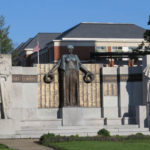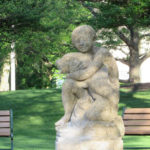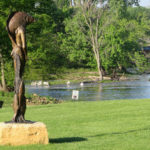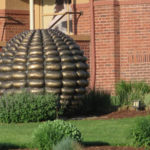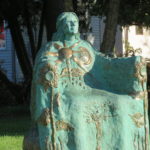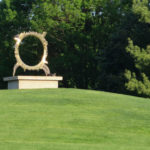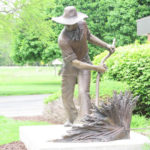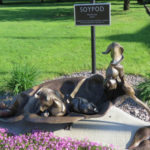Sculpture Trail

Historical sculpture has been on public display in Oregon since the time of Lorado Taft and the Eagle’s Nest Art Colony in the early 1900’s. The Community Art Legacy (C.A.L.) has been a contemporary project which added award winning public sculpture through-out town since 2004. These pieces were chosen from an annual competition. Costs of the project were supported by contributions community members and businesses; with casting completed by inBronze in Mt. Morris, IL. In 2011 C.A.L. created a brochure to provide the public with an easy to follow descriptive trail for viewing the public sculpture in Oregon. Since then, the final 3 of 10 sculptures have been completed and a new brochure is being developed. The Final piece is of John Phelps, the founder of Oregon, arriving at this location in 1833. It is on display in a landscaped setting on the west side of the Oregon Coliseum.
Download the map and brochure.
Sculptures Trail includes:
The statue The Eternal Indian, commonly called Black Hawk, was by Lorado Taft, 1911, in concrete, and can be seen from Rte. 2 across the Rock River and at Lowden State Park. The most iconic piece of artwork produced at the Eagles Nest Art Colony, the Eternal Indian was inspired by Lorado Taft’s appreciation for nature and for the people who first resided in Oregon, IL. Nicknamed “Blackhawk”, it is the second largest concrete monolith in the world and the largest in the northern hemisphere. This sculpture can be visited in Lowden State Park.
Seven Muses* By Students of Lorado Taft. Many of the exact details concerning the creation of this sculpture are unknown, but it is believed to be a work of students of Lorado Taft at the Eagles Nest Art Colony. This Sculpture is located on private property. Please obtain permission from Lorado Taft Field Campus before visiting this sculpture.
Makin’ Hay, by Daniel Ingebritson, 2010, is at Stillman Bank, north on Rte. 2, and captures the dynamic movement of the farmer’s strokes of the scythe through the hay.
The Holy Family is by David Seagrave, 1991, Located at the Church of St. Mary at the Corner of Rt 2 and Monroe St. This 3.5 ton statue depicting Mary, Joseph, and a young Jesus took over two years to complete before its dedication in 1991. It is carved from Indiana Limestone and was commissioned to celebrate the church’s 100 year anniversary.
From the Waters Comes My Bounty, by Ray Kobald, 2005, is located at Kiwanis Park at the west end of the dam of the Rock River. It depicts the generosity of the life-giving waters to all things.
Cornball, by Howard Russo, 2007, is located at the Coliseum, north of the Court House. It represents the increased global impact of corn to the world.
Expedition of the Rock River Valley By Steven Carpenter The final installation of the community art legacy project, Expedition of the Rock River Valley depicts the arrival of City of Oregon founder, John Phelps.
The Soldiers’ Monument, by Lorado Taft, dedicated in 1916, is located on the Court House square. The center fi gure is of bronze and the two adjacent soldier statues of marble. This honors veterans from the Civil War, Spanish-American War, War of 1812, Mexican War and World War I.
The Blind is a maquette of a sculpture by Lorado Taft, located at the University of Illinois. This is representative of the Eagles Nest Art Colony Collection, seen at the Oregon Public Library. This is a small scale plaster model used in the process of creating the full sized sculpture. The full size masterpiece is at the University of Illinois Champaign-Urbana.
The Kneeling Soldier By Jeff Adams The Kneeling Soldier honors all United States military members from Ogle County who laid down their lives in service of our nation. It can be seen just north of the Ogle County Courthouse.
The Bountiful Bench, by Christina Murphy, 2008, graces the lawn of the Oregon Public Library. Inspired by the beauty of the Rock River, the woman of nature and her coverlet hold the produce and natural bounty of the area.
Soy Pod By Pamela Lee, Located on the lawn of the Oregon Library, Soypod represents the symbiosis of crops and livestock in agriculture.
Agriculture, Mother of Civilization, by David Seagraves, 2006, is located at the Judicial Center, west of the Court House. Agriculture,
Mother of Civilization is a personification of the fertility of Ogle County Soil.
Harvest Moon, by Matthew Donavon, 2011, Harvest Moon, also called Harvest Hunter, captures a spectral barn owl in flight through a moonlit sky.
The Fish Boys, at Mix Park south on Route 2 are cast in a special blend of concrete of the original bronze sculptures by Lorado Taft, 1913, which are south of Chicago Art Institute.
Paths of Conviction, Footsteps of Fate, by Oregon sculptor, Jeff Adams, 2002, is located at Mix Park. It reflects on the crossing of the paths of Lincoln and Blackhawk and the struggles in this area in 1832.
Solar Reef, by Andrew Langoussis, 2009, is at the top of the hill at Oregon Park West. It represents the sun, the source of all energy, and through it can be seen the Court House and Oregon. Solar Reef is best viewed at sunrise. The fields, cities, and landscapes on the sculpture are illuminated with the sun at the center, symbolizing the sun supplying energy to the world.
Working the Land By Robert Pulley. Working the Land is a representation of the dynamic forces at work in historic and modern agriculture. Visit this sculpture in the Oregon Community Gardens north of the Rock River Center on 10th Street.
Come to the Wilderness* By Jeff Adams, 2008, is located at Lutheran Outdoors Ministries south of Oregon on Rte. 2. John the Baptist is pointing to the One inviting us to come to the wilderness.


